The demand for distance health technology in Japan is valued at USD 1.9 billion in 2025 and is projected to reach USD 6.0 billion by 2035, reflecting a compound annual growth rate of 12.2 percent. Growth is influenced by Japan’s aging population, increasing need for home-based care and broader acceptance of digital health tools within clinical and consumer settings. Remote monitoring systems, virtual consultations and connected diagnostic devices are becoming more common as healthcare providers seek efficient ways to manage chronic conditions and reduce pressure on hospitals. Continued investment in digital infrastructure and the expansion of user friendly health platforms reinforce the upward trend, supporting a strong shift toward technology enabled care throughout the forecast period.
The growth trajectory shows steady increases from earlier values of USD 1.0 billion and continues through USD 1.2 billion, USD 1.4 billion and USD 1.7 billion before reaching USD 1.9 billion in 2025. The pattern strengthens in later years as demand rises to USD 2.4 billion and USD 3.0 billion, followed by further expansion to USD 4.3 billion and USD 5.3 billion. By 2035 the value reaches USD 6.0 billion, reflecting sustained momentum across remote care services. Yearly gains remain consistent as digital health becomes more integrated into care pathways, supported by advances in monitoring technologies and increasing reliance on virtual care among older adults and healthcare institutions.

Demand in Japan for distance health technology is projected to grow from USD 1.9 billion in 2025 to USD 6.0 billion by 2035, reflecting a compound annual growth rate (CAGR) of approximately 12.2%. From USD 1.0 billion in 2020, demand rises steadily each year, reaching USD 1.9 billion in 2025, then expands further to USD 2.7 billion in 2028 and USD 4.3 billion in 2032, ultimately achieving USD 6.0 billion in 2035. This growth is driven by Japan’s rapidly aging population, increased prevalence of chronic diseases, rising demand for remote patient monitoring and teleconsultation platforms, and government initiatives to enhance healthcare digital transformation.
Technological innovation and infrastructure deployment will accelerate this demand. Improvements in AI analytics, IoT enabled devices, and 5G connectivity enhance remote diagnostics and telehealth services across Japan’s healthcare ecosystem. The national focus on medical digital transformation and interoperability of health information systems is creating favourable conditions for distance health technology adoption. As regulatory frameworks evolve and reimbursement models expand for remote care, the value per deployment will grow. The increasing uptake of virtual care and remote monitoring solutions by providers and payors will contribute significantly to the projected value reaching USD 6.0 billion by 2035.
| Metric | Value |
|---|---|
| Industry Value (2025) | USD 1.9 billion |
| Forecast Value (2035) | USD 6.0 billion |
| Forecast CAGR (2025–2035) | 12.2% |
The demand for distance health technology in Japan is driven by the country’s rapidly aging population and shrinking workforce. A growing proportion of elderly citizens requires long-term care and chronic disease management, while healthcare staffing remains tight in rural and remote regions. Remote monitoring, teleconsultations, and mobile health platforms respond to these pressures by extending care beyond traditional facilities. Japan’s strong digital infrastructure, combined with increasing acceptance of home-based health services, also contributes to rising use of distance health technologies.
Government policies aimed at lowering healthcare costs and improving access promote adoption of remote health solutions. Many providers and payers support innovations in wearable sensors, mobile applications, and virtual care models that enable early intervention and continuous monitoring. Data integration, digital platforms and connectivity improvements further enhance system efficiency. Privacy regulations and legacy information systems remain challenges, yet long-term demographic trends and strategic healthcare objectives underpin the commitment to distance health technology expansion in Japan.
The demand for distance health technology in Japan is influenced by the product types and applications within the healthcare sector. Key product types include telemedicine hardware, remote vital monitors, blood pressure devices, Bluetooth-enabled scales, and digital thermometers. These technologies are utilized in various applications, including teleconsultation, telehealth in disability, teleneurology, tele-physical therapy, and remote diet and nutrition counseling. These segments reflect Japan’s growing focus on healthcare innovation, driven by the aging population and the need to provide accessible and efficient healthcare services remotely.
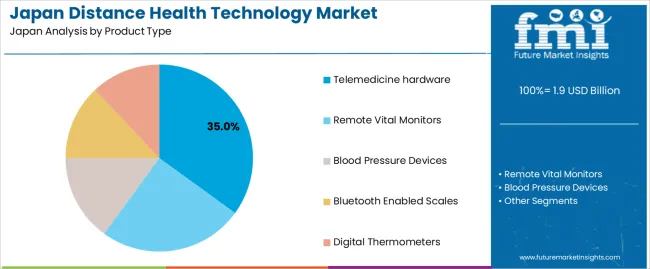
Telemedicine hardware accounts for 35% of the total demand for distance health technology in Japan. This category includes essential equipment such as video conferencing tools, specialized cameras, microphones, and other devices that facilitate remote medical consultations. The demand for telemedicine hardware is driven by Japan’s focus on expanding healthcare access, particularly to underserved regions and elderly populations who may have difficulty accessing traditional in-person medical services. Telemedicine hardware is vital in supporting Japan's health system, which is integrating more digital solutions to enhance care delivery.
The increasing adoption of telemedicine is also supported by Japan’s well-developed technological infrastructure, which enables seamless communication between healthcare providers and patients. As the country continues to address challenges posed by its aging population, the role of telemedicine hardware in delivering efficient, high-quality care remotely becomes even more significant. As telehealth adoption grows, the demand for advanced telemedicine hardware is expected to increase, ensuring the continued success and accessibility of virtual healthcare services.
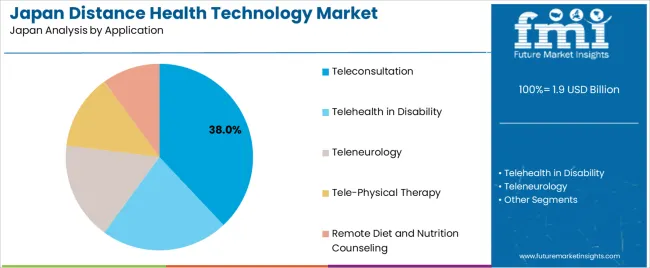
Teleconsultation accounts for 38.0% of the total demand for distance health technology in Japan. This application is especially important in Japan, where the elderly population is rapidly growing and remote healthcare options are becoming crucial for maintaining access to medical services. Teleconsultation allows patients to consult with healthcare professionals without having to leave their homes, offering convenience and reducing travel time, particularly for those living in rural areas or with mobility limitations.
The demand for teleconsultation is further driven by Japan's efforts to modernize its healthcare system and promote telemedicine as a solution to the challenges posed by an aging population. As the healthcare sector seeks to reduce the strain on in-person services and improve patient outcomes, teleconsultation has become an essential component of healthcare delivery. The continued integration of teleconsultation services, coupled with Japan’s technological advancements, ensures that demand for this application will continue to grow, providing more accessible care to a broader patient base.
The demand for distance health technology in Japan is expanding as the population ages and healthcare resources become stretched. The remote monitoring of chronic illnesses, virtual consultations and digital health platforms are becoming more common. The Japanese government’s supportive policy environment, together with advanced ICT infrastructure and increasing smartphone penetration, are contributing to adoption. Nonetheless, concerns around data privacy, uneven digital literacy, and heterogeneous regional infrastructure continue to influence the pace of uptake of these technologies.
What trend is contributing to the adoption of distance health technology in Japan?
Remote monitoring and virtual consultation services are increasingly used in Japan, particularly for elderly patients and those with chronic conditions. As the ratio of older adults climbs and mobility becomes limited, technology that enables care at home becomes valuable. The expansion of cloud based health platforms and wearables also supports remote health interventions. These changes result in broader interest from both providers and patients in distance health technologies across hospitals, clinics and home care settings.
What opportunity is available for distance health technology in Japan?
An opportunity lies in delivering healthcare services to underserved rural and remote areas of Japan via digital channels. Some regions face shortages of specialists or face difficult transport logistics. Distance health technology can bridge this gap by enabling consultations, diagnostics and follow up care without travel. With high internet penetration in urban areas and improving connectivity in rural zones, technology providers and healthcare systems have scope to expand remote care models and collaborate on platforms suited to local needs.
What barrier is limiting broader growth of distance health technology in Japan?
A key barrier for wider adoption of distance health technology in Japan is the variation in digital infrastructure and skills across regions and age groups. While many households have high speed internet, older adults may have lower familiarity with telehealth platforms. Further, concerns about data security and regulatory clarity inhibit some providers from implementing large scale remote care solutions. These factors slow how rapidly remote health care technologies can be scaled across all patient segments and geographies in Japan.

| Region | CAGR (%) |
|---|---|
| Kyushu & Okinawa | 15.2% |
| Kanto | 14.0% |
| Kinki | 12.3% |
| Chubu | 10.8% |
| Tohoku | 9.5% |
| Rest of Japan | 9.0% |
Demand for distance health technology in Japan is rising across all regions. Kyushu and Okinawa lead at 15.2%, supported by expanding digital health programs and growing use of remote care among aging communities. Kanto follows at 14.0%, shaped by its urban concentration and strong healthcare networks that integrate remote monitoring tools. Kinki records 12.3%, influenced by major hospitals and technology adoption in metropolitan areas. Chubu grows at 10.8% due to its industrial base and rising interest in virtual consultations. Tohoku reaches 9.5% with steady digital health expansion across rural and semi-urban areas. The rest of Japan grows at 9.0%, reflecting gradual adoption across smaller regions.
Kyushu & Okinawa is projected to grow at a CAGR of 15.2% through 2035 in demand for distance health technology. The region’s healthcare industry is increasingly adopting telemedicine and remote health monitoring solutions to improve accessibility, especially in rural areas. As healthcare providers in these regions work to expand digital healthcare services, distance health technology is becoming essential to deliver quality care. The rise in demand for healthcare efficiency, along with regional government support for health innovation, further accelerates the adoption of distance health technologies in Kyushu and Okinawa.
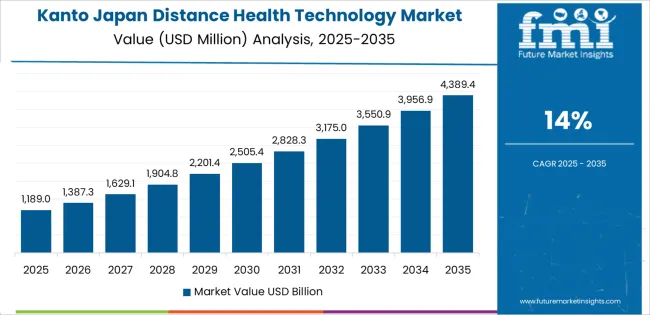
Kanto is projected to grow at a CAGR of 14.0% through 2035 in demand for distance health technology. As one of Japan’s most populous regions, Kanto, including Tokyo, leads in healthcare innovation and the adoption of telemedicine solutions. The region’s high concentration of healthcare providers, combined with the increased demand for accessible healthcare services, drives the use of distance health technologies. The rapid adoption of remote monitoring, virtual consultations, and digital health solutions is expected to grow as the region seeks to optimize healthcare delivery and reduce costs.
Kinki is projected to grow at a CAGR of 12.3% through 2035 in demand for distance health technology. The region’s strong healthcare infrastructure, particularly in Osaka and Kyoto, plays a key role in adopting telemedicine services and remote health monitoring. With a focus on improving healthcare access and efficiency, Kinki is increasingly integrating distance health technologies into its healthcare systems. The demand for remote consultation services, particularly in response to an aging population and increased chronic diseases, drives the growth of this market across the region.
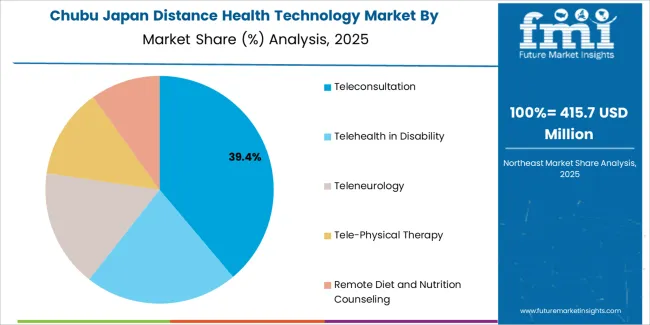
Chubu is projected to grow at a CAGR of 10.8% through 2035 in demand for distance health technology. The region’s industrial base and healthcare sector increasingly incorporate digital health solutions to improve care delivery and expand access. States like Aichi and Shizuoka, with a growing elderly population and strong healthcare networks, are adopting telemedicine and remote health monitoring to reduce patient visits and streamline healthcare services. Chubu’s focus on technological innovation and cost-effective healthcare further supports the growing use of distance health technologies.
Tohoku is projected to grow at a CAGR of 9.5% through 2035 in demand for distance health technology. The region, known for its rural areas and aging population, is increasingly turning to telemedicine to improve healthcare access. As healthcare providers in Tohoku work to overcome geographical barriers, remote health solutions such as virtual consultations and remote patient monitoring are becoming vital for delivering care. Additionally, regional government initiatives aimed at expanding digital healthcare services contribute to the adoption of distance health technologies in Tohoku.
The Rest of Japan is projected to grow at a CAGR of 9.0% through 2035 in demand for distance health technology. As regions outside major urban centers adopt telemedicine solutions, demand for remote health technologies continues to rise. Rural and suburban areas are increasingly using digital health services to bridge gaps in healthcare accessibility. The region’s emphasis on improving healthcare systems for elderly populations, coupled with growing interest in personalized healthcare services, accelerates the adoption of distance health technology to enhance patient care and reduce healthcare costs.
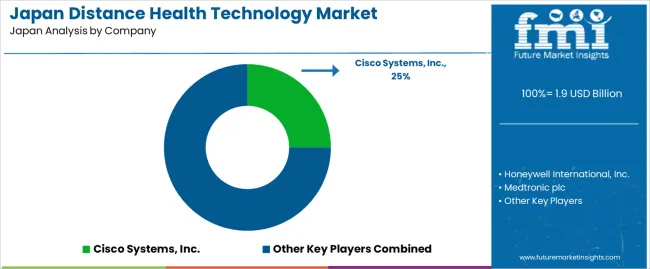
The demand for distance health technology in Japan is significantly driven by the country’s aging population and the rising prevalence of chronic diseases. As Japan's elderly population grows, there is a pressing need for remote monitoring and virtual healthcare services that can improve accessibility and efficiency. Additionally, the Japanese government has actively promoted digital healthcare solutions to alleviate pressures on the healthcare system and improve patient outcomes. Innovations in telemedicine, wearable health devices, and AI-based health monitoring tools are also increasing the appeal of distance health technologies. This shift is supported by Japan’s robust digital infrastructure, which enables seamless communication between healthcare providers and patients, even in rural areas, thus ensuring better healthcare coverage and timely intervention.
Key global companies shaping Japan’s distance health technology sector include Cisco Systems, Inc., Honeywell International, Inc., Medtronic plc, Koninklijke Philips N.V., and Teladoc Health, Inc. These companies provide a wide range of healthcare solutions tailored to the specific needs of the Japanese market. Cisco Systems is known for its networking infrastructure that supports telemedicine platforms, while Honeywell focuses on remote monitoring technologies. Medtronic offers connected medical devices that enable real-time health tracking, and Philips delivers integrated solutions for remote care and diagnostics. Teladoc Health, a leader in virtual healthcare, provides telehealth services and digital health platforms, helping streamline healthcare delivery in Japan. These players are crucial in driving the adoption and evolution of distance health technologies in Japan.
| Items | Values |
|---|---|
| Quantitative Units (2025) | USD billion |
| End Use | Hospitals, Clinics, Long Term Care Centres, Specialty Centers, Clinical Pharmacy Services |
| Product Type | Telemedicine hardware, Remote Vital Monitors, Blood Pressure Devices, Bluetooth Enabled Scales, Digital Thermometers |
| Application | Teleconsultation, Telehealth in Disability, Teleneurology, Tele-Physical Therapy, Remote Diet and Nutrition Counseling |
| Regions Covered | Kyushu & Okinawa, Kanto, Kinki, Chubu, Tohoku, Rest of Japan |
| Countries Covered | Japan |
| Key Companies Profiled | Cisco Systems, Inc., Honeywell International, Inc., Medtronic plc, Koninklijke Philips N.V., Teladoc Health, Inc. |
| Additional Attributes | Dollar by sales across product type, application, and end-use sectors, healthcare provider adoption rates, patient demand for remote healthcare, advancements in telemedicine infrastructure, and regulatory compliance in telehealth services. |
The demand for distance health technology in Japan is estimated to be valued at USD 1.9 billion in 2025.
The market size for the distance health technology in Japan is projected to reach USD 6.0 billion by 2035.
The demand for distance health technology in Japan is expected to grow at a 12.2% CAGR between 2025 and 2035.
The key product types in distance health technology in Japan are telemedicine hardware, remote vital monitors, blood pressure devices, bluetooth enabled scales and digital thermometers.
In terms of application, teleconsultation segment is expected to command 38.0% share in the distance health technology in Japan in 2025.






Our Research Products

The "Full Research Suite" delivers actionable market intel, deep dives on markets or technologies, so clients act faster, cut risk, and unlock growth.

The Leaderboard benchmarks and ranks top vendors, classifying them as Established Leaders, Leading Challengers, or Disruptors & Challengers.

Locates where complements amplify value and substitutes erode it, forecasting net impact by horizon

We deliver granular, decision-grade intel: market sizing, 5-year forecasts, pricing, adoption, usage, revenue, and operational KPIs—plus competitor tracking, regulation, and value chains—across 60 countries broadly.

Spot the shifts before they hit your P&L. We track inflection points, adoption curves, pricing moves, and ecosystem plays to show where demand is heading, why it is changing, and what to do next across high-growth markets and disruptive tech

Real-time reads of user behavior. We track shifting priorities, perceptions of today’s and next-gen services, and provider experience, then pace how fast tech moves from trial to adoption, blending buyer, consumer, and channel inputs with social signals (#WhySwitch, #UX).

Partner with our analyst team to build a custom report designed around your business priorities. From analysing market trends to assessing competitors or crafting bespoke datasets, we tailor insights to your needs.
Supplier Intelligence
Discovery & Profiling
Capacity & Footprint
Performance & Risk
Compliance & Governance
Commercial Readiness
Who Supplies Whom
Scorecards & Shortlists
Playbooks & Docs
Category Intelligence
Definition & Scope
Demand & Use Cases
Cost Drivers
Market Structure
Supply Chain Map
Trade & Policy
Operating Norms
Deliverables
Buyer Intelligence
Account Basics
Spend & Scope
Procurement Model
Vendor Requirements
Terms & Policies
Entry Strategy
Pain Points & Triggers
Outputs
Pricing Analysis
Benchmarks
Trends
Should-Cost
Indexation
Landed Cost
Commercial Terms
Deliverables
Brand Analysis
Positioning & Value Prop
Share & Presence
Customer Evidence
Go-to-Market
Digital & Reputation
Compliance & Trust
KPIs & Gaps
Outputs
Full Research Suite comprises of:
Market outlook & trends analysis
Interviews & case studies
Strategic recommendations
Vendor profiles & capabilities analysis
5-year forecasts
8 regions and 60+ country-level data splits
Market segment data splits
12 months of continuous data updates
DELIVERED AS:
PDF EXCEL ONLINE
Demand Signal Repository Solutions Market Size and Share Forecast Outlook 2025 to 2035
Demand Side Management Market Size and Share Forecast Outlook 2025 to 2035
Demand Response Market Analysis - Size, Share, and Forecast Outlook 2025 to 2035
North America Shipping Supplies Market Trends – Innovations & Growth 2024-2034
Demand of Kozani Saffron in Greece Analysis - Size, Share & Forecast 2025 to 2035
Demand of No-acid Whey Strained Dairy Processing Concepts in European Union Size and Share Forecast Outlook 2025 to 2035
Demand for Bronte Pistachio in Italy Analysis - Size, Share & Forecast 2025 to 2035
Demand and Trend Analysis of Gaming Monitor in Western Europe Size and Share Forecast Outlook 2025 to 2035
Demand and Trend Analysis of Gaming Monitor in Korea Size and Share Forecast Outlook 2025 to 2035
Demand and Trend Analysis of Gaming Monitor in Japan Size and Share Forecast Outlook 2025 to 2035
Glycine Soja (Soybean) Seed Extract Market Size and Share Forecast Outlook 2025 to 2035
Demand and Trend Analysis of Yeast in Japan - Size, Share, and Forecast Outlook 2025 to 2035
Demand of Pistachio-based desserts & ingredients in France Analysis - Size, Share & Forecast 2025 to 2035
Western Europe Men’s Skincare Market Analysis – Forecast 2023-2033
Demand and Trends Analysis of Stevia in Japan Size and Share Forecast Outlook 2025 to 2035
Japan Women’s Intimate Care Market Trends – Growth & Forecast 2024-2034
Demand and Trend Analysis of Fabric Stain Remover in Korea Size and Share Forecast Outlook 2025 to 2035
Demand and Sales Analysis of Paper Cup in Korea Size and Share Forecast Outlook 2025 to 2035
Demand and Sales Analysis of Paper Cup in Western Europe Size and Share Forecast Outlook 2025 to 2035
Demand of MFGM-enriched Powders & RTDs in European Union Size and Share Forecast Outlook 2025 to 2035

Thank you!
You will receive an email from our Business Development Manager. Please be sure to check your SPAM/JUNK folder too.
Chat With
MaRIA